
Episode 10 : "Where are "springs" used in a car?" (No.5)
Hello everyone. The Japanese Golden Week spring holidays are coming up soon. How will you be spending the holidays? Perhaps taking a leisure trip?
I guess some people who don't like crowds would rather sit around at home, but I think it is nice to feel the seasons change just by going to a nearby park or river. If you go by car, remember to drive carefully.
Today's theme is about where springs are used in cars.
PIOLAX elasticity (spring) products are used mainly in the: (1) Fuel system, (2) Drive system, (3) Open/close mechanisms, (4) Fasteners, (5) Harnesses, (6) Precision parts, and (7) Clamp parts.
Last time, I introduced fastener products, so this time, I am going to explain harness products intended for harnessing other parts like wire bundles

Resin products for harnesses are band clips or other clips used either to bundle electric wires (called the wiring harness) running throughout a car like human blood vessels, or to fix them to a car body panel. These harness resin products are manufactured at our group's overseas factories and sold to local wiring harness makers.
It's hard to see the various clips for the car wiring harness, but you can see some of them by opening the hood.
In addition to cars, resin clips are used in many other applications where they are often called cable ties. In the future, environment-friendly harness resin products will come into widespread practical use.
That's all on this theme now.
Cars are being computerized rapidly by systems like CAN (Controller Area Network). Initially, CAN was used only for luxury cars, but now it is being adopted in many models. As a result, the number of wiring harnesses carrying electric signals has decreased. The harness weight used to be about 30% of a car's gross weight, but this has fallen to less than 20% and will fall even more in the future.

However, although harness weight is dropping, the number of wiring directions is increasing as computerization progresses.
Also, the FlexRay intra-car network will be adopted within 3 to 5 years. When FlexRay is used, wheels will be turned by electric signals rather that today's mechanical parts. This will increase the number of harnesses, but significantly reduce gross weight because mechanical parts weigh more than harnesses. Making cars lighter reduces fuel consumption and helps solve environmental problems.
Next time, I shall talk about precision parts, so don't miss it!Bye for now.
Written by Banekko (a child of spring)




